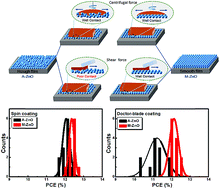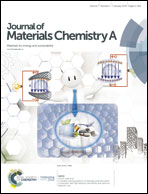12.88% efficiency in doctor-blade coated organic solar cells through optimizing the surface morphology of a ZnO cathode buffer layer†
Abstract
Doctor-blade coating (DBC) is a roll-to-roll compatible high-throughput thin film fabrication route with little solution wastage and is considered as a more scalable method for the fabrication of organic solar cells (OSCs) than spin coating (SC). Since wet film drying is much slower during DBC than during SC, the interfacial connection within the films might be different, which could remarkably influence the device performance of OSCs. In this work, we demonstrated that the device performance, reproducibility, and long-term stability are more sensitive to the ZnO morphology in doctor-blade (DB)-coated cells than in spin-coated cells in both fullerene (PTB7-Th:PC71BM) and non-fullerene (PBDB-TF:IT-4F) systems. Such an influence is more significant in large-area cells. We ascribe this enormous difference between the spin-coated and DB-coated devices to different interfacial contacts, which were caused by different spreading forces and drying kinetics during the thin film formation process. A smooth ZnO cathode buffer layer from methanol-dispersed inks was more suitable for DBC, and with this layer, a high power conversion efficiency of 12.88% and 9.22% was achieved for the 0.12 and 1.04 cm2 DB-coated PBDB-TF:IT-4F OSCs, respectively.



 Please wait while we load your content...
Please wait while we load your content...